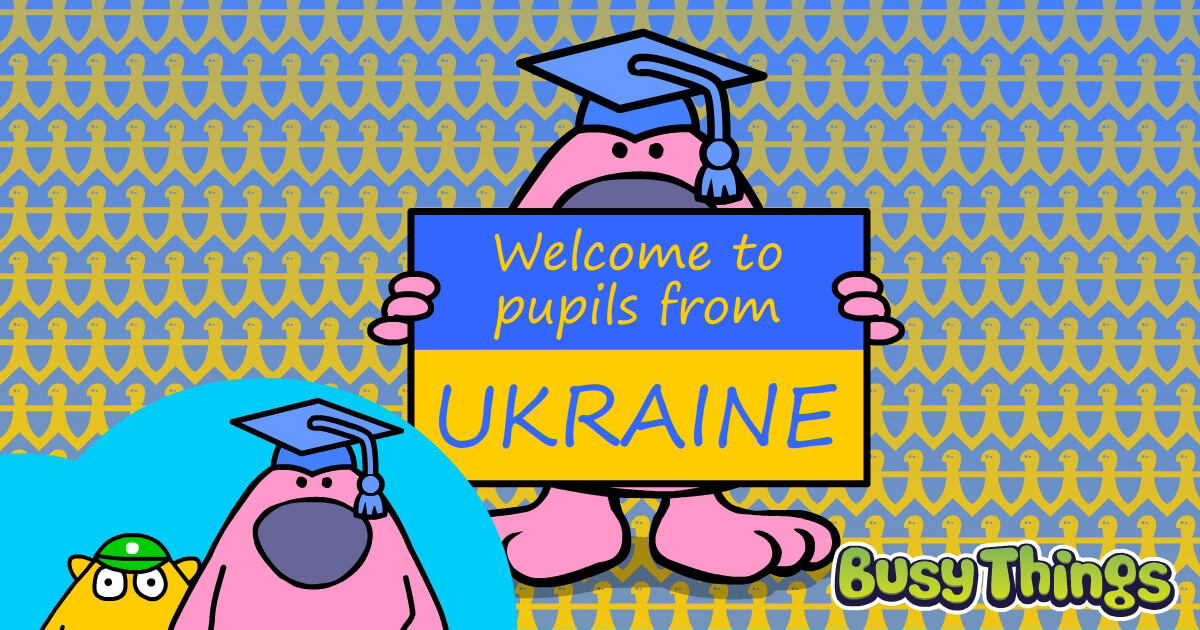Welcoming Pupils from Ukraine

We’ve seen on several Facebook Groups that many teachers are really struggling with new arrivals from war-torn Ukraine, who are both traumatised from their experiences and speak very little English.
With 9,900 pupils having already secured places in UK schools as of 9th June, this is something perhaps not all schools have experienced to date, but with up to 100,000 school places being made available, it’s definitely something schools should have a plan for as the situation in Ukraine develops.
In this blog, we’ll be providing practical hints and tips on how you could help a Ukrainian pupil settle into your primary school. As Busy Things is not an EAL resource, we cannot help develop their formal English language skills but we can help you by:
- helping them feel welcome and safe,
- helping them engage and socialise with your existing pupils,
- giving you some breathing space to develop a plan of action.
Background information
As always, the more information you can acquire about your new pupils upfront, the better, but this information will be hard to come by given the situation the children have come from. Do ensure you know what the child’s first language is though as this is critical. Only 67% of the Ukrainian population give Ukrainian as their mother tongue; 30% speak Russian.
If you can find out how many years of schooling the child has already had, that would also be useful. Ukrainian children do not usually start school until they are 6 or 7 years of age.
Preparations prior to the pupil’s arrival
Just as with any other pupil joining mid-term, you’d look to provide everything that a new pupil would need to help the day run smoothly, i.e., a peg for their coat, space for their bag and PE kit, a drawer for their work etc. You’d sort out a suitable classroom buddy to help them settle into the school routine and play with them at break and lunchtimes.
Give them a warm welcome
Given the different extreme circumstances and trauma the children have inevitably suffered, it’s brilliant if you can provide an even warmer welcome than norm. The children will inevitably feel very insecure, having had all normality stripped from their lives, so would definitely appreciate any gestures of support.

Prepare the other children for the newcomer by teaching them about what has happened in Ukraine, encourage them to create a welcome banner or something similar, and get them involved by asking them to come up with ideas that could help the new pupil in the short term.
Overcome the language barrier
It’s a huge challenge coming to a school where you don’t speak any of the language. Being able to communicate in any shape or form will undoubtedly bolster your new pupil’s confidence. Some schools are lucky and have children that speak Ukrainian/Russian already, and this would undoubtedly help the child settle in more quickly. If that’s not the case for your school, however, you’ll need to think about other options. Could you perhaps invite a member of the child’s family to come with them to give them extra support in the first few days? Do you need some frequently used phrases in crib sheet form or access to Google Translate?
Add visual signposts around the school
Looking at non-emotional support, visually signposting important areas is essential. Once you know your pupil’s language of preference, you can start.

Some of the most-needed phrases and vocabulary will be around parts of the school, so signposting the toilets, classrooms, dining hall and other communal areas, giving the Ukrainian/Russian and its English equivalent, will really help. You could use our Publisher tool and Clip art to help you do this!
Prepare a lanyard or ring of picture cards for the pupil to carry around too, like this one on pages 22-26, so that he/she always has the tools to communicate.
Acquire Ukrainian/Russian books
Last but not least, see what books you can acquire in the child’s mother tongue. It will show you’ve made a huge effort and provide just a little bit of normality in what is an overwhelming situation.
Schools can acquire a Bookmark Box of English language and Ukrainian books by registering their interest here.
When the pupil arrives
The most important thing when the pupil arrives is for them to get accustomed to the space and feel safe. As with all newcomers, show them around, indicating what the most important areas are, and ensure one of the other children buddy-up with them.
Give them visual supports to help. This will include the signposting already mentioned but also provide them with a visual timetable each day, so that they understand what will be happening when.
In terms of activities, don’t expect too much of them to start with. Learning can wait until they feel settled and you have a proper plan of action laid out and resourced.
Encourage play-based learning on a resource like Busy Things, and feed off what they like to do. There are a multitude of Art and Music activities on Busy Things that they can play and explore. These games are open-ended with no right or wrong answer and also have no spoken instructions. The children can be encouraged to set up their own avatar and you can customise their setups so that they focus on the areas that you think they’ll benefit from most.
When they seem ready to engage, you can talk to them about their situation and where they are with their learning, so you can work out what support and resources they need to move ahead as an individual.
We’d love to know what really worked for your school when welcoming Ukrainian pupils, so please do let us know in the comments. If there are any resources you’d recommend to other teachers in the same boat, please do feel free to share them here!